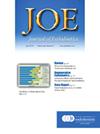热杀死的Lancefieldella rimae通过促进破骨细胞分化诱导骨吸收。
IF 3.5
2区 医学
Q1 DENTISTRY, ORAL SURGERY & MEDICINE
引用次数: 0
摘要
导言:根尖牙周炎主要由牙髓中的细菌感染引起,通常伴有脓肿、根尖周炎和牙槽骨缺损。最近,在根尖牙周炎患者的根管内发现了Lancefieldella rimae。在此,我们研究了 L. rimae 是否与骨吸收有关:方法:对 L. rimae 进行厌氧培养和热杀灭(HKLr)。方法:对L. rimae进行厌氧培养和热杀灭(HKLr),使用小鼠腓骨植入模型测定体内骨吸收情况。在有或没有 HKLr 的情况下,制备的 C57BL/6 野生型或 Toll 样受体 2(TLR2)缺陷小鼠的承诺破骨细胞被分化成成熟的破骨细胞。采用实时反转录聚合酶链反应对抗酒石酸磷酸酶(TRAP)、ATPase H+ 运输 V0 亚基 D2(Atp6v0d2)、酪蛋白酶 K、IL-6、TNF-α 和 3-磷酸甘油醛脱氢酶(GAPDH)的 mRNA 表达进行了定量。c-FOS 和 NFATc1 的蛋白水平通过 Western 印迹分析进行测定:结果:将 HKLr 植入小鼠腓肠肌会导致骨破坏,并增加 TRAP 阳性区域。HKLr能促进破骨细胞的分化,但在TLR2缺陷的破骨细胞中却观察不到这种效应。HKLr 可剂量依赖性地增加破骨细胞分化相关基因(包括 TRAP、Atp6v0d2 和 cathepsin K)的 mRNA 表达。此外,HKLr 还增加了 IL-6 和 TNF-α 的表达:结论:L. rimae通过TLR2信号通路增强破骨细胞分化,从而诱导骨吸收,这意味着L. rimae是牙根尖牙周炎牙槽骨吸收的致病因子。本文章由计算机程序翻译,如有差异,请以英文原文为准。
Heat-killed Lancefieldella Rimae Induces Bone Resorption by Promoting Osteoclast Differentiation
Introduction
Apical periodontitis, mainly caused by bacterial infection in the dental pulp, is often accompanied by abscess, periapical inflammation, and alveolar bone loss. Lancefieldella rimae has been detected in the root canals of patients with apical periodontitis. Here, we investigated whether L. rimae is associated with bone resorption.
Methods
L. rimae was anaerobically cultured and heat-killed (HKLr). A mouse calvarial implantation model was used to determine the bone resorption in vivo. Committed osteoclasts prepared from C57BL/6 wild-type or Toll-like receptor 2 (TLR2)-deficient mice were differentiated into mature osteoclasts in the presence or absence of HKLr. The mRNA expression of tartrate-resistant acid phosphatase (TRAP), ATPase H+ transporting V0 subunit D2, cathepsin K, interleukin-6, tumor necrosis factor-α, and glyceraldehyde 3-phosphate dehydrogenase was quantified using real-time reverse transcription-polymerase chain reaction. The protein levels of c-Fos and NFATc1 were determined by Western blot analysis.
Results
Implantation of HKLr onto the mouse calvaria induced the bone destruction with an increase of TRAP-positive areas. While HKLr enhanced the differentiation of osteoclasts, this effect was not observed in TLR2-deficient osteoclasts. HKLr dose-dependently increased the mRNA expression of genes associated with osteoclast differentiation including TRAP, ATPase H+ transporting V0 subunit D2, and cathepsin K. In addition, HKLr enhanced the expression of c-Fos and NFATc1, which are important transcription factors for osteoclast differentiation. Moreover, HKLr increased the expression of interleukin-6 and tumor necrosis factor-α.
Conclusion
L. rimae induces bone resorption by enhancing osteoclast differentiation through the TLR2 signaling pathway, implying that L. rimae is a causative agent responsible for the alveolar bone resorption accompanying apical periodontitis.
求助全文
通过发布文献求助,成功后即可免费获取论文全文。
去求助
来源期刊

Journal of endodontics
医学-牙科与口腔外科
CiteScore
8.80
自引率
9.50%
发文量
224
审稿时长
42 days
期刊介绍:
The Journal of Endodontics, the official journal of the American Association of Endodontists, publishes scientific articles, case reports and comparison studies evaluating materials and methods of pulp conservation and endodontic treatment. Endodontists and general dentists can learn about new concepts in root canal treatment and the latest advances in techniques and instrumentation in the one journal that helps them keep pace with rapid changes in this field.
 求助内容:
求助内容: 应助结果提醒方式:
应助结果提醒方式:


